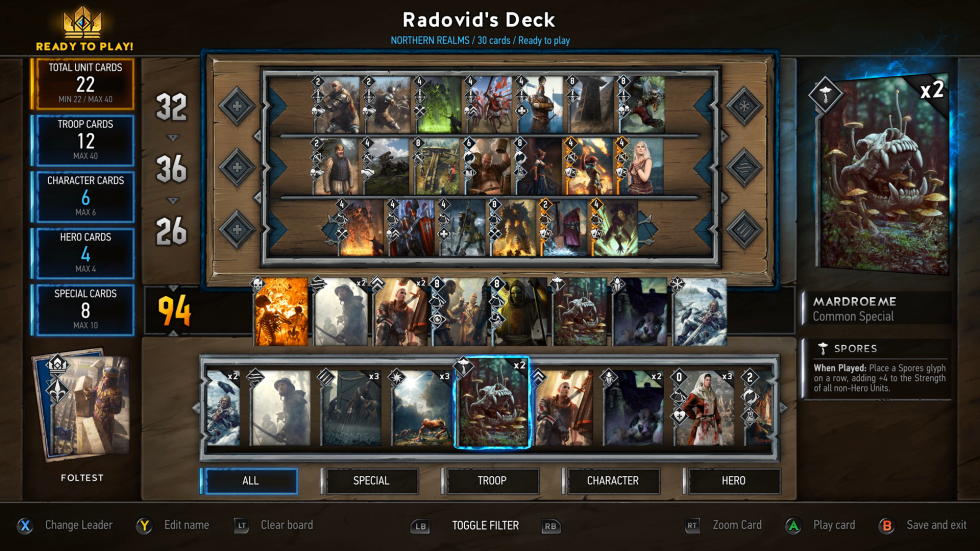
Didn't you hear? Collectible card games are all the rage these days, what with Blizzard's Hearthstone sporting over 20 million players, Magic: The Gathering going through some kind of renaissance, and publishers like Bethesda definitely not trying to cash in on the whole thing with games like The Elder Scrolls: Legends. And so at this year's E3 we have yet another entry in the genre from developers CD Projekt Red: a Witcher 3 spin-off called Gwent. The difference is that Gwent is far more than just a collectible card game. This one has an honest-to-god proper storyline. There's even an open-world map to explore.
For the uninitiated, Gwent was originally a collectible card game embedded into the vast world of The Witcher 3. Only, as player data began to trickle in, CD Projekt Red discovered that many players were spending hours roaming inns during quests just to play Gwent. Some even ignored the main game entirely. This was more than enough incentive for the developer to spin Gwent off into its own free-to-play game across PC, Xbox One, and PlayStation 4. And in true CD Projekt Red fashion, it's gone a little overboard in the process.
Instead of just pitching players against each another in one-on-one card battles, Gwent features several single-player campaigns. Each has its own unique storyline and lead character and is fully voice acted, and each is brought to life via some highly stylised 2D drawings that gently slide across the screen. There's even an overworld map where—in the demo I was shown, at least—you control a cute 2D Geralt to explore and find hidden snippets of story or extra cards to add to your deck. Each campaign is said to last a whopping 10 hours or so, too.
Clearly, no one told CD Projekt Red that the real joy of collectible card games is sticking it to other players online or face-to-face. But for those heavily invested in The Witcher universe, or those who would rather not suffer the indignation of losing to a surprisingly skilled 12-year-old online, the single-player campaign could prove very entertaining indeed. Still, the meat of the action is in playing other people, and sure enough, the demo on show at E3 is a multiplayer one—and it is quite slick.
Gwent is similar to other collectible card games in that each card in a deck has a particular set of points, attributes, and skills that can affect other cards in the deck and/or the opposition. There's also a combat type (melee, ranged, siege) that indicates which position the card takes on a three-tiered board. At the start of a round each player receives 10 random cards from their deck, and are given the opportunity to swap up to three of them for other cards. From there it's all about strategically placing cards on the board, with the ultimate aim being to have more points on the board than the opposition.
It's a simple concept, but like Hearthstone or Magic there's a huge amount of depth. Aside from trying to assemble the strongest deck possible—often by shedding weaker unit cards in favour of those with special buffs—you have to know when to play the strongest cards. Play them all too early in order to win the first round, and you're weakened for the all-important second round.
Then there are the weather cards, which can have a dramatic effect on the opposition by weakening an entire row. Relying on them isn't always wise, though, particularly as there are cards that can immediately remedy any ill effects.
The sheer amount of possible card combinations and strategies mean that Gwent has a steep learning curve. I never really bothered with the game that much in The Witcher 3—there are way more things to do than just play cards—and my first few games of Gwent were spent pawing through the pre-made demo decks desperately trying to figure out what on earth everything did. It wasn't until my fifth match that I had some grasp of how the game worked, and how best to lay out my cards.
While I didn't manage to win a match, I can see the appeal. The detail on the cards, the way they light up and bounce as a well-placed weather effect sucks half the points away from the opposition, or that sinking feeling as an unanticipated special card from the opposition lays waste to an intricately constructed row—it's all wonderfully compelling.
Like any collectible card game, Gwent will require a significant time investment to find the best cards and come up with effective strategies. There will also be questions surrounding the purpose of premium 3D animated cards, which appear randomly in purchased booster packs of cards (yup, Gwent has those as well).
But these are just minor tribulations in a game that has the potential to be not just a competitor to Hearthstone, but a fantastic card game in its own right. And who knows? With a fanbase as passionate as that of The Witcher, it might even be a more popular one, too.
reader comments
38